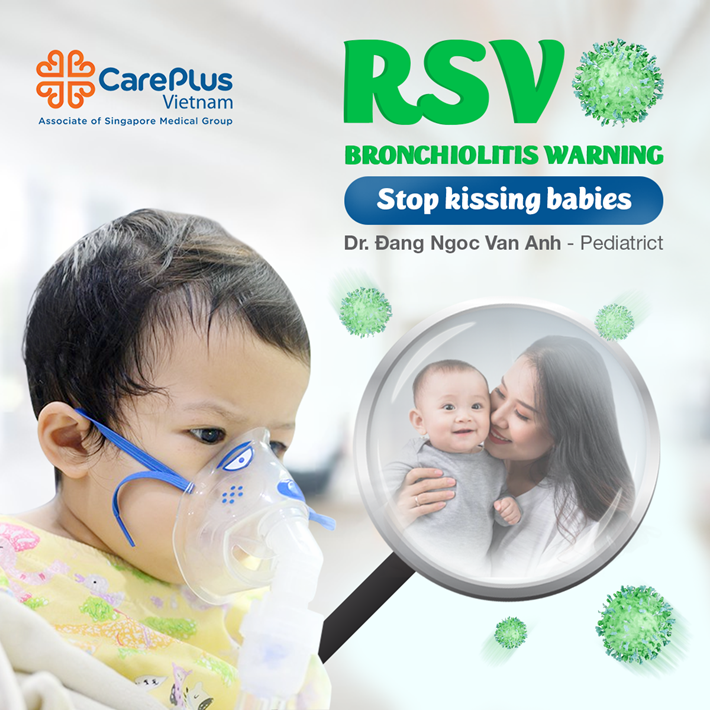RSV Bronchiolitis warning: "Stop kissing babies"
In children, infection with the above viruses is possible due to their weak resistance, especially when receiving a kiss from a person who is or was previously infected with the RSV virus.

1/23/2024 9:45:10 AM
In the cold season, when temperatures drop to low levels, many viruses will have the opportunity to appear more substantial, some types (RSV) of which can cause respiratory infections, flu, and colds. Cold and cough for both adults.
In children, infection with the above viruses is possible due to their weak resistance, especially when receiving a kiss from a person who is or was previously infected with the RSV virus.
According to doctors, the RSV virus is the cause of bronchitis and pneumonia in infants. Among them, pneumonia is especially dangerous, which is considered the "biggest killer" of young children.
Define:
Bronchiolitis is an infection that affects a part of the lungs called the "bronchioles." Bronchioles are small, many-branched tubes < 2mm in size that carry air into and out of the lungs. When these tubes become infected, they swell and become clogged with mucus, making breathing difficult for the child.
.jpg)
-
Common in children under 24 months old, primarily seen in children under 12 months old.
-
The disease occurs all year round, peaking during the rainy season in the South and the cold season in the North.
-
The disease progresses quickly and easily into an epidemic in winter and spring, with initial symptoms like the common flu.
-
Respiratory Syncytial Virus (RSV) is the leading cause of Bronchiolitis.
-
The disease is spread by direct contact with sick people in the family or ill children in daycare, through respiratory droplets when coughing or sneezing, or indirectly through the caregiver's hands or the child's toys.
The RSV virus invades and multiplies in the upper respiratory tract. The virus is fixed and continues to grow and spread to the baby's bronchiolar epithelial cells, causing:
-
Necrosis of the respiratory epithelium
-
Destruction of villous cells
-
Mononuclear cell infiltration
-
Then, cell debris and fibrin fibers will form bronchial plugs, causing alveolar air congestion and creating symptoms of wheezing and difficulty breathing during expiration.
If the bronchial lumen is completely blocked, it will cause a collapsed lung.
Clinical :
Starting with symptoms of viral infection (fever, cough, runny nose), a day or two later, the child wheezes and breathes rapidly, has chest constriction, is fussy, and has poor feeding.
-
Babies can become dehydrated due to fever, rapid breathing, and poor feeding.
-
We may hear wheezing, wheezing, or wet crackles during lung examination.
-
Pay special attention to infants under six weeks old who may only have apnea without other symptoms.
-
Children are too young < 3 months old
-
Premature babies, especially under 32 weeks
-
Children with concomitant congenital heart disease
-
Children with chronic lung disease
-
Immunocompromised children
-
Severe malnutrition
-
Chromosomal abnormalities or neuromuscular disease
Treatment:
Mild cases can be treated as outpatients, mainly symptomatic treatment:
-
Adequate hydration is essential in Bronchiolitis.
-
Maintain nutrition and breastfeed your baby as usual.
-
Clear the airways with isotonic saline Sodium Chloride 0.9%
-
Do not arbitrarily use hypertonic saline aerosol, a bronchodilator, antibiotic, or anti-inflammatory.
(1).jpg)
Closely monitor the child's disease progression
Re-examine after two days, and tell the child to come back for examination immediately if there are any of the following severe signs: not feeding, high fever, abnormal breathing (rapid breathing, irregular breathing, apnea), paleness, and restlessness. , stimulation, and perceptual disturbances.
In severe cases, children need to be hospitalized for respiratory support with oxygen and treatment for complications, including respiratory failure and infection.
Progression: most children's wheezing reduces after 3-4 days and completely recovers within 1-2 weeks.
Children can also become seriously ill with complications of respiratory failure and bacterial infections, making treatment difficult, prolonged, and at risk of death.
Clinical :
Starting with symptoms of viral infection (fever, cough, runny nose), a day or two later, the child wheezes and breathes rapidly, has chest constriction, is fussy, and has poor feeding.
-
Babies can become dehydrated due to fever, rapid breathing, and poor feeding.
-
We may hear wheezing, wheezing, or wet crackles during lung examination.
-
Pay special attention to infants under six weeks old who may only have apnea without other symptoms.
-
Clean hand hygiene is the most important. Adults should clean their hands before taking care of children. For older children, they should practice the habit of washing their hands with soap before eating and after using the toilet.
-
Avoid letting children come into contact with people who are sick or have signs of acute respiratory infection.
-
Gently refuse when relatives want to kiss the child by holding out the baby's hand for everyone to kiss instead of kissing the cheek.
-
Wash your hands thoroughly before holding your baby.
-
Avoid exposing children to cigarette smoke and dusty environments.
-
Annual flu vaccination for children six months and older.
According to doctors, mothers should delicately refuse kisses from others to their children to protect their children's health. If you are afraid of misunderstandings, you can explain to everyone the harmful effects of kissing. Take care of your children scientifically to stay healthy